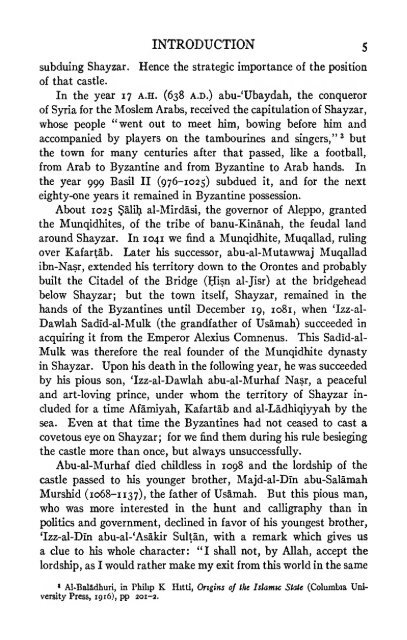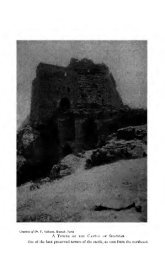Create successful ePaper yourself
Turn your PDF publications into a flip-book with our unique Google optimized e-Paper software.
subdu<strong>in</strong>g Shayzar.<br />
<strong>of</strong> that castle.<br />
INTRODUCTION 5<br />
Hence <strong>the</strong> strategic importance <strong>of</strong> <strong>the</strong> position<br />
In <strong>the</strong> year 17 a.h. (638 a.d.) abu-'Ubaydah, <strong>the</strong> conqueror<br />
<strong>of</strong> Syria for <strong>the</strong> Moslem <strong>Arab</strong>s, received <strong>the</strong> capitulation <strong>of</strong> Shayzar,<br />
whose people "went out to meet him, bow<strong>in</strong>g before him <strong>and</strong><br />
accompanied by players on <strong>the</strong> tambour<strong>in</strong>es <strong>and</strong> s<strong>in</strong>gers," 3<br />
<strong>the</strong> town for many centuries after that passed, like a football,<br />
from <strong>Arab</strong> to Byzant<strong>in</strong>e <strong>and</strong> from Byzant<strong>in</strong>e to <strong>Arab</strong> h<strong>and</strong>s.<br />
but<br />
<strong>the</strong> year 999 Basil II (976-1025) subdued it, <strong>and</strong> for <strong>the</strong> next<br />
eighty-one years it rema<strong>in</strong>ed <strong>in</strong> Byzant<strong>in</strong>e possession.<br />
About 1025 §alih al-Mirdasi, <strong>the</strong> governor <strong>of</strong> Aleppo, granted<br />
<strong>the</strong> Munqidhites, <strong>of</strong> <strong>the</strong> tribe <strong>of</strong><br />
around Shayzar.<br />
In<br />
banu-K<strong>in</strong>anah, <strong>the</strong> feudal l<strong>and</strong><br />
In 1041 we f<strong>in</strong>d a Munqidhite, Muqallad, rul<strong>in</strong>g<br />
over Kafartab. Later his successor, abu-al-Mutawwaj Muqallad<br />
ibn-Nasr, extended his territory down to <strong>the</strong> Orontes <strong>and</strong> probably<br />
built <strong>the</strong> Citadel <strong>of</strong> <strong>the</strong> Bridge (Hisn al-Jisr) at <strong>the</strong> bridgehead<br />
below Shayzar; but <strong>the</strong> town itself, Shayzar, rema<strong>in</strong>ed <strong>in</strong> <strong>the</strong><br />
h<strong>and</strong>s <strong>of</strong> <strong>the</strong> Byzant<strong>in</strong>es until December 19, 1081, when 'Izz-al-<br />
Dawlah Sadid-al-Mulk (<strong>the</strong> gr<strong>and</strong>fa<strong>the</strong>r <strong>of</strong> Usamah) succeeded <strong>in</strong><br />
acquir<strong>in</strong>g it from <strong>the</strong> Emperor Alexius Comnenus. This Sadld-al-<br />
Mulk was <strong>the</strong>refore <strong>the</strong> real founder <strong>of</strong> <strong>the</strong> Munqidhite dynasty<br />
<strong>in</strong> Shayzar. Upon his death <strong>in</strong> <strong>the</strong> follow<strong>in</strong>g year, he was succeeded<br />
by his pious son, 'Izz-al-Dawlah abu-al-Murhaf Nasr, a peaceful<br />
<strong>and</strong> art-lov<strong>in</strong>g pr<strong>in</strong>ce, under whom <strong>the</strong> territory <strong>of</strong> Shayzar <strong>in</strong>cluded<br />
for a time Afamiyah, Kafartab <strong>and</strong> al-Ladhiqiyyah by <strong>the</strong><br />
sea. Even at that time <strong>the</strong> Byzant<strong>in</strong>es had not ceased to cast a<br />
covetous eye on Shayzar; for we f<strong>in</strong>d <strong>the</strong>m dur<strong>in</strong>g his rule besieg<strong>in</strong>g<br />
<strong>the</strong> castle more than once, but always unsuccessfully.<br />
Abu-al-Murhaf died childless <strong>in</strong><br />
1098 <strong>and</strong> <strong>the</strong> lordship <strong>of</strong> <strong>the</strong><br />
castle passed to his younger bro<strong>the</strong>r, Majd-al-D<strong>in</strong> abu-Salamah<br />
Murshid (1068-1137), <strong>the</strong> fa<strong>the</strong>r <strong>of</strong> Usamah. But this pious man,<br />
who was more <strong>in</strong>terested <strong>in</strong> <strong>the</strong> hunt <strong>and</strong> calligraphy than <strong>in</strong><br />
politics <strong>and</strong> government, decl<strong>in</strong>ed <strong>in</strong> favor <strong>of</strong> his youngest bro<strong>the</strong>r,<br />
'Izz-al-D<strong>in</strong> abu-al-'Asakir Sultan, with a remark which gives us<br />
a clue to his whole character: "I shall not, by Allah, accept <strong>the</strong><br />
lordship, as I would ra<strong>the</strong>r make my exit from this world <strong>in</strong> <strong>the</strong> same<br />
* Al-Baladhuri, <strong>in</strong> Philip K Hitti, Orig<strong>in</strong>s <strong>of</strong> <strong>the</strong> Islamic State (Columbia University<br />
Press, 1916), pp 201-2.



